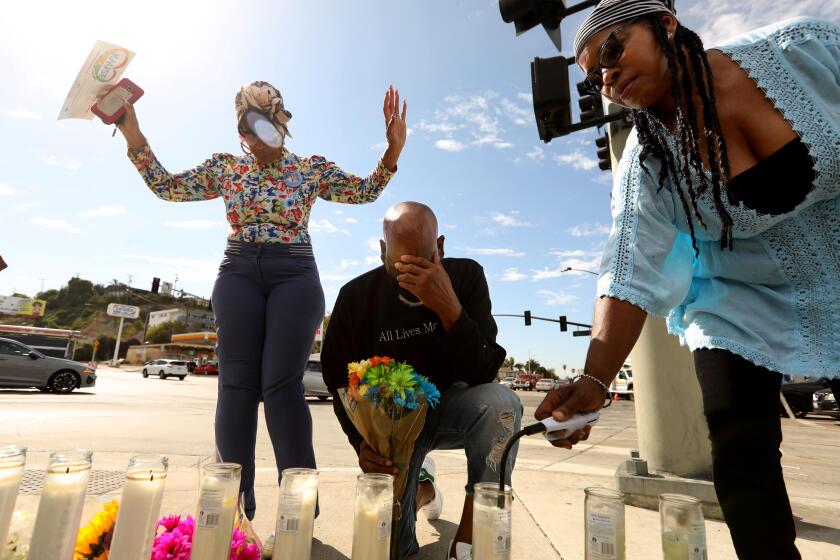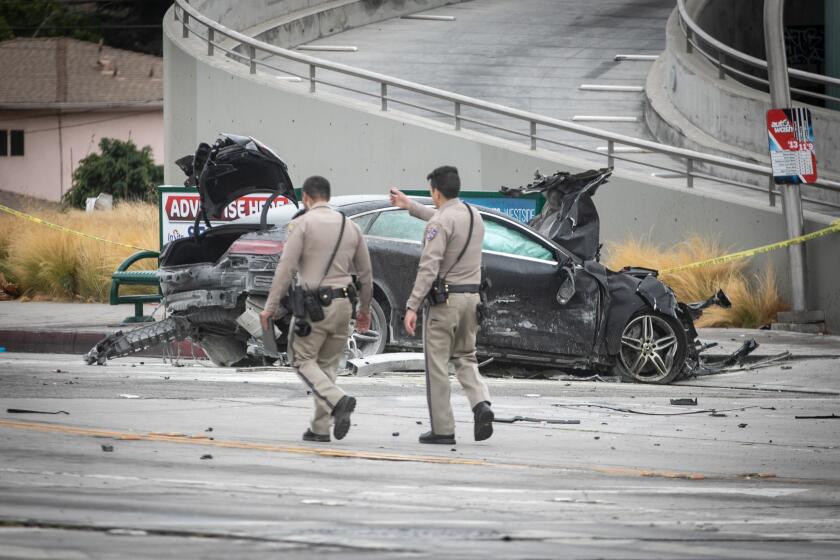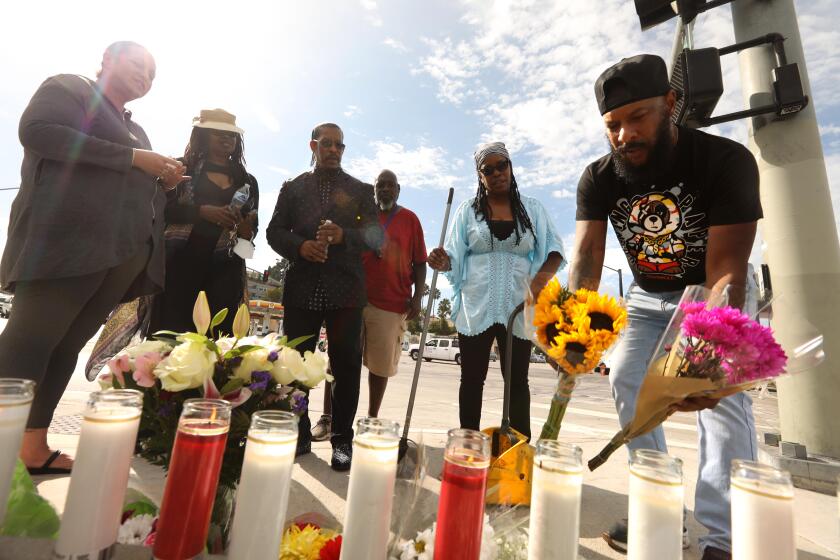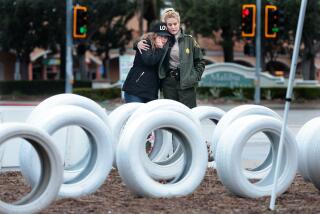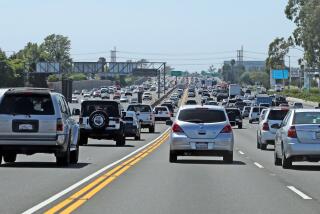Column: Mercedes crash that killed 5 galvanizes an L.A. movement: No more fast and furious
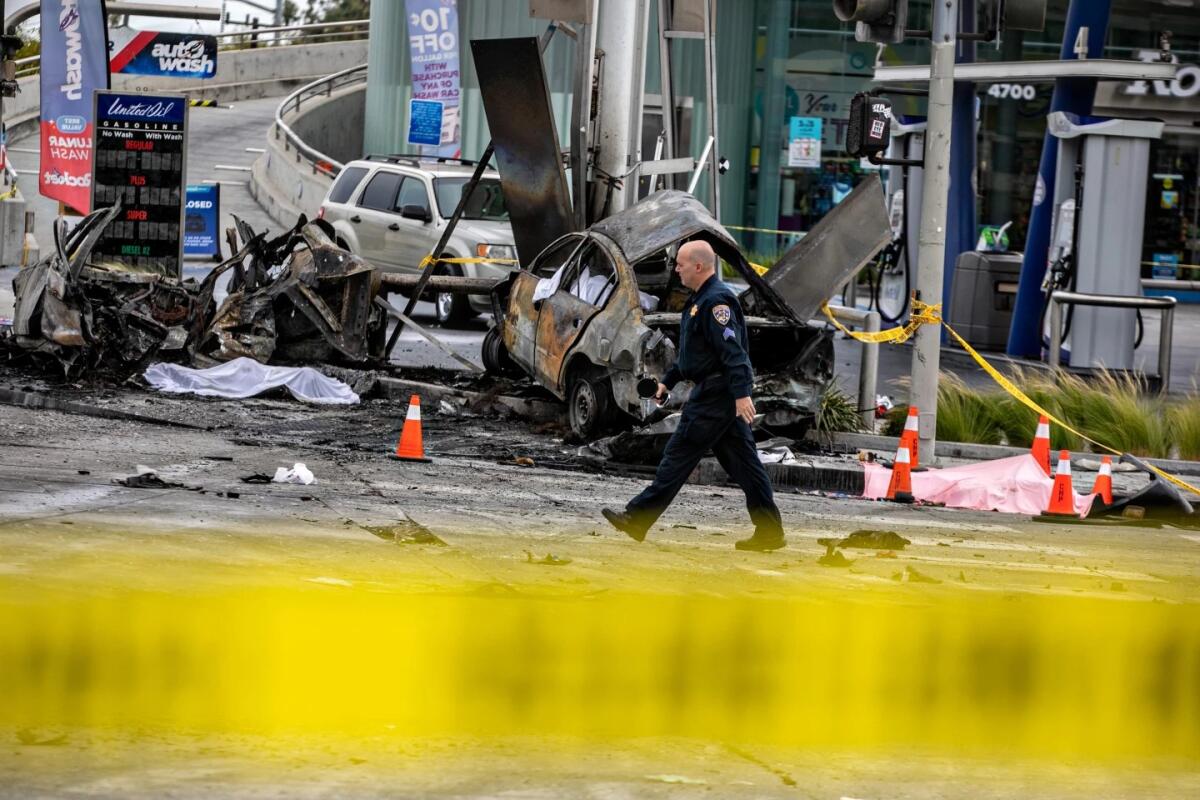
In Los Angeles, people have had it with speeding.
They want more enforcement, stiffer penalties for offenders and better street design, and they want to know why — even as we move toward electric vehicles to save the planet — the auto industry produces gas-guzzling behemoths that easily go twice the highest speed limits, and why the media culture celebrates velocity.
After my Sunday column about the high-speed Windsor Hills crash last week that killed five people, including a pregnant woman, residents weighed in with stories of unchecked reckless driving in their own neighborhoods, along with proposals to crack down on the carnage.
In Angelino Heights, residents are rallying to stop the scheduled filming of a scene from “Fast & Furious” later this month, worried that yet another appearance in the popular film series will create even more mayhem in the neighborhood.
A registered nurse has been arrested and will be booked on vehicular manslaughter charges in the fiery Windsor Hills car crash that killed five people.
“We will not stand for them filming here,” says a letter that was emailed to City Hall, arguing that the moviemakers “do nothing to dissuade their macho fans from endangering people’s lives on public streets in Los Angeles.”
Ralph Hattenbach says an accident is “waiting to happen” near the corner of Sepulveda and 76th in Westchester.
Authorities are trying to determine whether Linton was supposed to be taking medications and if she was using them at the time of the crash, law enforcement sources told The Times.
“There is a stoplight at 76th heading east, and cars take off speeding down the road all day heading towards the 405,” said Hattenbach, “and I never see any police watching or ticketing speeders.”
“Have you checked out what the neighborhood calls the Ventura Boulevard Speedway?” asked Barrie Benton. “That would be Ventura Boulevard from Winnetka to De Soto. Three lanes in each direction bordered on each end by a school.”
And in mid-city Los Angeles, says UCLA urban planning professor Mike Manville, residents are enduring the effects of unanswered pleas for street safety improvements that would protect pedestrians, cyclists and motorists.
On Melrose Avenue, Manville said, “almost every weekend, we have burnouts and stunt bikers and all sorts of people driving dangerously. We should enforce speed limits, but the best speed limit is a road that doesn’t let you speed. But our city engineers and City Council members for some reason think we need to have highways running through our neighborhoods.”
Damian Kevitt of the nonprofit Streets Are for Everyone said the site of last week’s Windsor Hills crash has a long history of tragic collisions. He said there have been 29 crashes since 2010, with 42 people injured or killed.
“The 2.2-mile section of La Brea leading to the intersection of Slauson and La Brea is a high-speed six-lane road going through residential zones, several parks … and a public elementary school,” Kevitt said last week in a news release.
Kevitt, who lost his leg in 2013 after he was struck by a minivan while riding his bike, has long been a critic of the slow pace of street safety projects, even in the years since Mayor Eric Garcetti launched Vision Zero in 2015 with a goal of eliminating vehicular deaths by 2025. There have been 176 traffic collision deaths so far this year, compared with 162 at the same point in 2021 and 122 in 2020.
Nicole Lorraine Linton, 37, has been charged with multiple counts of murder and vehicular homicide in the six-car collision in Windsor Hills, and police say her car blew through a red light and into the intersection at 90 mph or more.
Law enforcement sources told The Times that Linton, a nurse, was involved in 13 previous wrecks, which, if true, raises the question of why, or whether, she was still licensed to drive. In court this week, a defense attorney said she had a history of mental health issues.
Pastor Patricia Strong-Fargas of Mt. Salem New-Wave Christian Fellowship told me her 6-year-old granddaughter attends a preschool near La Brea and Slauson. She said the child, and others, heard the collision and the “screaming and hollering” of horrified witnesses.
“I’m trying to get some trauma care for them,” said Strong-Fargas, who has been trying for a couple of years now to get drivers everywhere to slow down after witnessing constant speeding at the intersection of Figueroa and 87th Place, the home of her church.
“One of my homeless individuals was preparing to move into transitional housing, and he was crossing the street on Central Avenue and was hit and killed by a car,” said Strong-Fargas. “I said, ‘Enough is enough.’ ”
Some legislators have tried to do something, but several bills to control speeding have failed. And I don’t think it’s a stretch to say that whereas national Republican lawmakers have failed to support sensible gun control proposals despite the ongoing firearm carnage, the Democrats who dominate the California Legislature have been missing in action when it comes to cracking down on drivers who use vehicles as weapons.
But Assemblymember Laura Friedman (D-Glendale) and state Sen. Henry Stern (D-Malibu) aren’t giving up.
Stern’s Senate Bill 1472 would tweak the penal code to allow prosecutors to charge drivers with voluntary manslaughter in deaths involving street racing, the popular and dangerous sideshows, and drivers doing 100 mph or more.
“I started to get to know a community of victims,” said Stern, who told me that in addition to re-engineering streets to make them safer, there have to be stiffer penalties in cases where death by vehicle isn’t an accident of mechanical failure or driver health emergency.
“These are murders, it’s just a different kind of weapon” — a weapon that is killing more people than guns, Stern said.
“There’s a staggering rate of carnage,” Friedman said, not just locally but nationwide. “If we had 30,000 people a year dying in plane crashes, we would long ago have grounded our plane fleet.”
She said she thinks there’s a lot of “entitled behavior” and “something going on in our culture where people feel like it’s their right … to drive very aggressively, with a lack of respect for others. … I see people who are ... clearly going 90 and 100 mph.”
Windsor Hills speeding claims five more lives as vehicles become weapons of mass destruction.
Friedman is still frustrated by more than one failed effort to push speed-control legislation through Sacramento, most recently in a proposal that called for speed enforcement cameras in high-collision areas in a five-city pilot program.
She said she modified the bill, Assembly Bill 2336, to answer concerns about admissibility and accuracy of camera-driven citations, about whether low-income people of color would be disproportionately penalized, and whether some would be unwilling to pay fines.
The first offense would have been a warning, Friedman told me, and ability to pay would be a consideration. And money generated would have gone into road safety improvements in high-collision minority neighborhoods where people are disproportionately injured and killed, she said. She’s still livid that the bill failed, but determined to make another run at it before the year is out.
“I think we also have to hold auto manufacturers accountable,” Friedman said. They’re all about making the inside of vehicles safer, even as bigger, more powerful vehicles put everyone at greater risk. So why not use technology to make it impossible for cars to go faster than the posted speed limit?
I’m with her on that, and also with readers who railed against television car ads — and TV shows and movies — that sell speed.
“I am sick and tired of these knucklehead street racers speeding and doing doughnuts in our neighborhood,” said Echo Park resident Alan Lee, who lives near a market featured in one of the “Fast & Furious” movies. The market draws speeders and stunt drivers, Lee said, and he saw one lose control and plow into a neighbor’s car.
Michele McKinnon said tenants in her Echo Park apartment building complain of stunt driving and the smell of burned rubber, a familiar scent on weekend evenings. The “Fast & Furious” franchise has made billions glorifying “deadly street racing,” McKinnon said in an email to city officials, promising to disrupt filming “all day and night” in honor of those who have lost their lives to reckless driving.
She said she’s still awaiting a formal response from the city.
More to Read
Sign up for Essential California
The most important California stories and recommendations in your inbox every morning.
You may occasionally receive promotional content from the Los Angeles Times.

